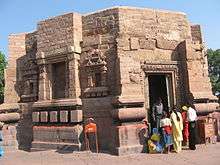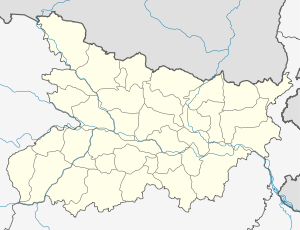Mundeshwari Temple
| Mundeshwari Temple | |
|---|---|
 Nagara style architecture of the temple. | |
 Location in Bihar | |
| Geography | |
| Coordinates | 24°59′00″N 83°33′53″E / 24.9833958°N 83.5646939°ECoordinates: 24°59′00″N 83°33′53″E / 24.9833958°N 83.5646939°E |
| Country | India |
| State | Bihar |
| District | Kaimur district |
| Location | Kaura |
| Elevation | 608 m (1,995 ft) |
| Culture | |
| Sanctum | Shiva and Shakthi |
| Major festivals | Ramnavami, Shivratri, Navaratra. |
| Architecture | |
| Number of temples | One |
| History | |
| Date built | 119 CE[1][2] |
| Website | http://maamundeshwari.org |
The Mundeshwari Devi Temple (also spelled as Mundesvari) is located at Kaura in Kaimur district in the state of Bihar, India on the Mundeshwari Hills. It is an ancient temple dedicated to the worship of Lord Shiva and Shakti and is considered one of the oldest Hindu temples in India.[3][4][5] It is also considered as the oldest functional Hindu temple of India.[6][7]
The information plaque erected by the Archaeological Survey of India (ASI) at the site indicates the dating of the temple to 119 CE. Hindu inscriptions dated 119 CE were found in the temple.[8] The temple is a protected monument under ASI since 1915.
Geography
The Mundeshwari Devi temple is located on the Mundeshwari Hill at an elevation of 608 feet (185 m).[3] Located on Kaimur plateau near Son River,(and Survuwara(suvara) river) there are many archaeological relics on the Mundeshwari Hill.[9]
How To Reach
It can be reached by road via Patna, Gaya, or Varanasi. The nearest railway station is at Mohania - Bhabua Road railway station from where the temple is 22 km by road.[10]
Lal Bahadur Shastri International Airport, Varanasi is the nearest airport, located at a distance of 102 km from the Temple. Indian carriers including Air India, Jet Airways, Kingfisher Airlines, Spicejet, and international carriers like Air India, Thai Airways International, Korean Air and Naaz Airlines operate from here. Daily flights to Delhi, Mumbai and Kolkata are available from here.
Architecture
The temple, built of stone, is on an octagonal plan which is rare. It is the earliest specimen of the Nagara style of temple architecture in Bihar. There are doors or windows on four sides and small niches for the reception of statues in the remaining four walls.[11] The temple shikhara or tower has been destroyed. However, a roof has been built, as part of renovation work. The interior walls have niches and bold mouldings which are carved with vase and foliage designs. At the entrance to the temple, the door jambs are seen with carved images of Dvarapalas, Ganga, Yamuna and many other murtis. The main deities in the sanctum sanctorum of the temple are of the Devi Mundeshwari and Chaturmukh (four faced) Shiva linga. There are also two stone vessels of unusual design.[12] Even though the Shiva linga is installed in the centre of the sanctum, the main presiding deity is Devi Mundeshwari deified inside a niche, which is seen with ten hands holding symbols riding a buffalo, attributed to Mahishasuramardini.[13] The temple also has murtis of other popular gods such as Ganesha, Surya and Vishnu. A substantial part of this stone structure has been damaged, and many stone fragments are seen strewn around the temple. However, under the jurisdiction of ASI, it has been the subject of archaeological study for quite some time.[4][5][10][14]
Worship

It is believed that rituals and worship have been performed here without a break, hence Mundeshwari is considered one of the most ancient Hindu temples in India. The temple is visited by a large number of pilgrims each year, particularly during the Ramnavami, Shivratri festivals.[5] A big annual fair (mela) is held nearby during the Navaratra visited by thousands.[16] The worship of shakti in the form of Devi Mundeshwari in the temple is also indicative of tantric cult of worship, which is practiced in Eastern India.[5]
Renovation and restoration
The Archaeological Survey of India is restoring the temple under instruction from the Union Ministry of Culture. Restorative works include the removal of soot from the temple interior via a chemical treatment, repair of damage to religious murti and cataloging and documentation of scattered fragments for later reuse. Other works include installation of solar powered lighting, displays for antiquities and provision of public amenities. The Government of Bihar has allocated Rs 2 crore to improve access to the temple.[17][14]
References
- ↑ The information plaque erected by the Archaeological Survey of India (ASI) at the site indicates the dating of the temple to 119 CE.

- ↑ Hindu inscriptions dated 119 CE were found in the temple.Sajnani, Manohar (2001). Encyclopaedia of Tourism Resources in India. Gyan Publishing House. ISBN 9788178350172.
- 1 2 "Alphabetical List of Monuments – Bihar". Serial number 62. Archaeological Survey of India.
- 1 2 "BSBRT to renovate Mundeshwari temple". Times of India. 1 January 2011. Retrieved 2 June 2011.
- 1 2 3 4 "Ma Mundeshwari Temple in Kaimur ,Bihar". Hindu Temples. Retrieved 2 June 2011.
- ↑ "Film on 'oldest' surviving temple of Gupta Age". The Times Of India. 12 June 2011.
- ↑ "Bihar to develop 'oldest' temple". The Times Of India. 18 January 2008.
- ↑ Sajnani, Manohar (2001). Encyclopaedia of Tourism Resources in India. Gyan Publishing House. ISBN 9788178350172.
- ↑ L.S.S. O`malley (2005). Bihar And Orissa Gazetteers Shahabad. Concept Publishing Company. pp. 36, 157. ISBN 978-81-7268-122-7. Retrieved 4 June 2011.
- 1 2 "Maa Mundeshwari Mandir". Google.com. Retrieved 4 June 2011.
- ↑ "Mundesvari". Hindu Books.org. Retrieved 5 June 2011.
- ↑ "Mundeshwari temple". Plaque by Archaeological Survey of India. Retrieved 2 June 2011.
- ↑ "Mundesvari". Hindu Books.org. Retrieved 5 June 2011.
- 1 2 "Facelift to the Mundeshwari temple". Hindustan Times. 3 January 2011. Retrieved 5 June 2011.
- ↑ Sajnani, Manohar (2001). Encyclopaedia of Tourism Resources in India. Gyan Publishing House. ISBN 9788178350172.
- ↑ "Temples and Legends of Bihar, Mundeshwari". Hindubooks.org. p. 11. Retrieved 5 June 2011.
- ↑ "Govt to develop Ma Mundeshwari Temple". Bihar Times. 19 January 2008. Retrieved 2 June 2011.
External links
| Wikimedia Commons has media related to Mundeshwari Temple. |